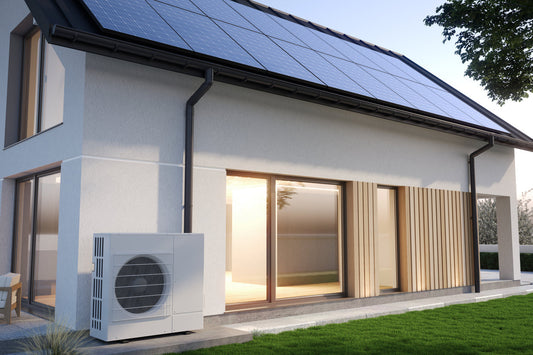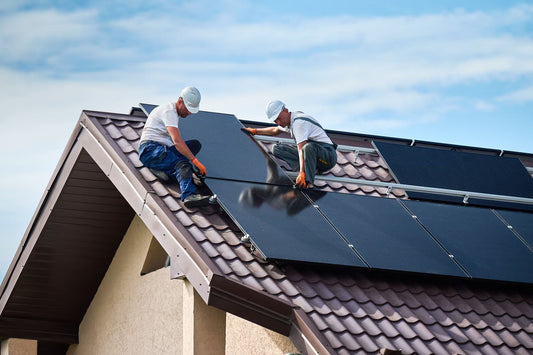The feed-in tariff 2025: These changes now come into force.

Feed-in tariff: The most important information at a glance
The feed-in tariff is the payment you receive when you feed your self-generated solar power into the public grid. Currently, the feed-in tariff is 7.94 cents per kWh and applies to photovoltaic systems commissioned between February 1, 2025, and July 31, 2025.
This feed-in tariff is reduced by 1% every six months, with the next reduction taking place on August 1, 2025. The new Solar Peak Act could reduce the tariff by up to 30%. Further details can be found below.
In general, feed-in tariffs represent a stable source of income, potentially generating several hundred euros annually. However, they are usually less attractive compared to direct marketing. We will discuss this further below in the article.
What exactly is the feed-in tariff?
The feed-in tariff is the money you receive for solar power that you don't use yourself but feed into the public grid. It was introduced in 2000 as part of the Renewable Energy Sources Act (EEG) to motivate private households to purchase solar power systems and thus support the energy transition.
The principle is simple: For every kilowatt-hour (kWh) of solar power you feed into the grid, you receive a fixed payment from the grid operator. The amount of this payment is regulated by law and depends on various factors, such as when the photovoltaic system was commissioned, the size of the system, and the type of feed-in (full feed-in or surplus feed-in).
Difference between full feed-in and excess feed-in
At the Full feed-in All the generated electricity is fed into the grid. This means that the self-produced electricity is not used directly; instead, electricity is drawn from the grid.
At the Excess feed-in Only the electricity that cannot be used directly or stored is fed into the grid. Since the feed-in tariff is now only a few cents per kilowatt-hour, feeding in surplus electricity is widespread. It is more economically sensible to use the solar power yourself.
What will the feed-in tariff be in 2025?
The feed-in tariff is currently 7.94 cents per kWh and applies from February 1, 2025, to July 31, 2025. All PV systems commissioned during this period will receive this subsidy for 20 years. The exact amount of the tariff depends on the size of the PV system and the type of feed-in. Generally, the larger the system, the lower the tariff.
Feed-in tariff for surplus feed-in
PV system output; feed-in tariff amount up to
- 10 kWp 7.94 cents/kWh
- up to 40 kWp 6.88 cents/kWh
- up to 100 kWp 5.62 cents/kWh
Feed-in tariff for full feed-in
PV system output, feed-in tariff amount (up to)
- 10 kWp 12.60 cents/kWh
- up to 40 kWp 10.56 cents/kWh
- up to 100 kWp 10.56 cents/kWh
What does the new energy law mean for feed-in tariffs?
The German Bundestag recently passed amendments to the Renewable Energy Sources Act (EEG), which are expected to come into force on March 1, 2025. Some of these amendments affect feed-in tariffs and could lead to a decrease in revenue from these tariffs by up to 30%. However, the feed-in tariff will not be completely abolished.
Here are the two most important changes:
Those who cannot steer must throttle back.
If a photovoltaic system is not equipped with a smart meter and a control device and is operated under the government feed-in tariff scheme, the feed-in power is limited to 60% ("active power limitation"). This means that operators can only feed a portion of the generated energy into the grid.
No more feed-in tariffs when electricity prices are negative
Currently, operators of solar power plants receive feed-in tariffs even when the electricity price is negative. This causes additional costs for the government, as there is too much electricity in the grid, and the excess electricity should actually be drawn from the grid, resulting in a negative electricity price. Nevertheless, the fed-in electricity is compensated. To prevent this, the Solar Peak Act stipulates that no compensation will be paid when the electricity price is negative.
These two measures together could lead to a decrease in feed-in tariff revenues of up to 30%.
Good to know: The periods during which the electricity price was negative and no feed-in tariff was paid are added to the regular 20-year feed-in tariff period. This means that the lost quarter-hours during which the electricity price was negative are counted towards the entire 20-year tariff period.
Is the feed-in tariff still worthwhile?
The feed-in tariff remains a reliable and stable source of income, typically generating a few hundred euros per year. However, compared to direct marketing, the feed-in tariff is often less profitable.
The advantage of direct marketing is that the electricity is not fed into the grid at a fixed feed-in tariff. Instead, it is sold on the electricity exchange, which generally allows for significantly higher revenues for PV operators.
Do you have questions or
do you need help?
Our team of experts is happy to process your inquiries or assist with any questions about our products.
5000+
Satisfied Customers
1500+
Projects Completed
+10 Years
Experience in Climate Technology





